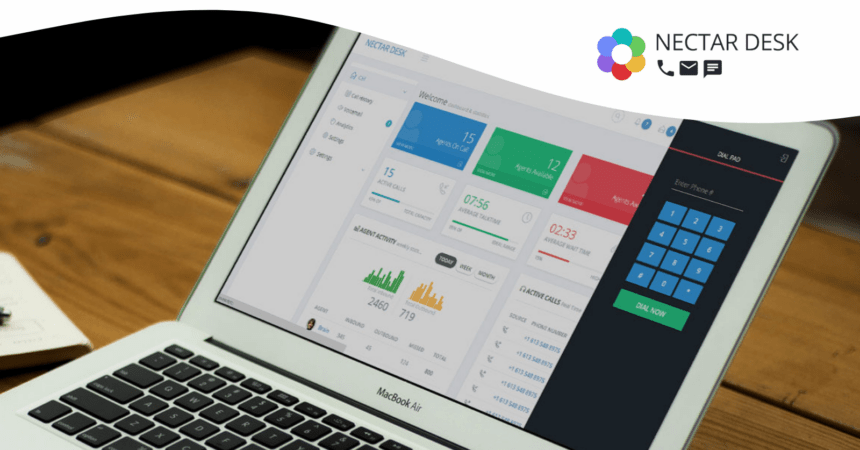“I’m happy about what SalesNash does for Nectar Desk. They are handling the important part of our processes and are doing good. They are result-oriented and did their best to minimize the learning curve, which is the main reason I work with them for almost 3 years”.

SalesNash played a key role in helping Nectar Desk build a sales team from the scratch.
40
appointments
60
%
open rates
About Nectar Desk
Nectar Desk is a Canadian SaaS company. It provides a cloud-based call center solution and VoIP service for B2B and B2C businesses. Nectar Desk features include IVR, Auto Dialer, SMS/Email Channel, analytics and stats, Task Management, and much more.
Computer Software
Industry
Canada
Location
Ottawa
Headquarters
Building Sales Team
Campaign type
Summary
An idea to make your in-house sales team is a high priority for a recently founded software company. But the whole operation would take time, a lot of time. Moreover, growing a proper sales department requires considerable investments, new strategy development, tactics implementation, and whatnot. Hiring a professional ready-made sales team saves an enormous amount of time and, eventually, money.
Nectar Desk had a limited budget and wanted to build a sales team, and after that a sales development team. So they decided to hire SalesNash team to put their business development plans into action.
Challenges
In the current state of the market, call center solution platform faces huge competition. It has to deal with such giants as RingCentral, Five9, 8×8, Talkdesk and dozens of smaller ones. To stay afloat, NectarDesk wanted to build strong sales channels, both inbound and outbound. Yet, there have appeared three main problems:
Training for sales executives
Nectar Desk platform is sophisticated to learn and make demos. Sales executives should get along with the technologies and be prepared to define customers’ needs by offering the rights solutions. Systematic follow-ups and high-performance rates are necessary for the company’s sales growth.
Difficulties with outbound campaigns
Inbound lead flow is not stable in such a competitive market, and the cost of the lead was pretty high. Nectar Desk had a need to focus on the outbound process to get their best-fit clients. The first step in building a sales channel lies in proper lead generation. It’s crucial to specify the research vector, select potentially the most valuable one and be precise as much as possible during the prospect generation.
Inbound lead flow is not stable
Even though Nectar Desk works for 99% of businesses that have a call center, running outbound campaigns is not simple work. Outbound campaigns have to be relevant, intriguing and not misleading at the same time. Here’s the point when lead generation, content writing, and SDR teams should work in complete synergy. Otherwise, we would end up marked as spam and be far away from making sales thriving.
Solutions
Lead Generation
Before starting lead generation our research department explored the whole client’s industry. Then we investigated the most common customer profile to remove possible drawbacks during the further stages. At the beginning of cooperation with Nectar Desk, we assigned lead generation specialists who helped to set initial Ideal Customer Profiles and selected the first industry vertical to cover. Primarily, we targeted integration and competitors’ users. Any kind of information could appear helpful for the email outreach, so we segmented lead generation data into various categories like industry, average company size, geographic location, phone number, working field, types of integration a prospect uses, etc. This approach helped to conduct valid campaigns as we had more variables for messaging.
There are some risks of running several outbound campaigns at the same time. The most obvious reason is that it may look like spam which, definitely, damages the brand. To avoid such a fate our lead gen team was laser-focused on the quality of the leads, targeting decision-makers who were more likely to be interested in Nectar Desk solutions. For that the whole lead gen process was manual, that is our team generated all the prospects one by one, precisely selecting potentially the right one.
Sales Outreach
Once a broad lead database was built, the outreach stage began. Nectar Desk created individual domains for both SDR and Sales Executive. Then our sales team composed several email sequences to make sure we were sending as many messages as it’s required to get the prospects’ attention and not to bother them. Our initial focus was on integrated CRM and competitor users outreach. And the first metrics turned out to be promising – 75% open rate and 25% response rate.
The SDR was responsible for the whole cadence – made response and follow-up operations on email, LinkedIn, and SMS campaigns. It’s important to gather all the supplementary metrics which should dictate all the future cadences. Such data usually includes positive and negative responses, types of those responses, open rates, click rates, and other information that may be useful.
Together with the lead gen department, the sales team moved forward to explore and occupy other parts of the market. We expanded our research and outreach effort for new industry niches and geographical regions. For instance, answering, booking, and courier services in Europe and Australia. Yet, the North American region remained the most prosperous one.
Content Writing
Our content writers composed personalized emails and messages to cover all the outreach channels. So, ad hoc templates were fully customized and took into account the specifics of a particular campaign. Doesn’t matter whether it was email, LinkedIn, or SMS outreach. Moreover, the sales team did a bunch of email deliverability tests. It’s essential to monitor email sending issues since it directly affects the sales results. In most cases, copywriters made wording and templates changes that improved deliverability noticeably. thriving.
Inbound and Outbound Sales
Our Sales Executive studied the technology platform to get to know all the details about its performance, advantages, possibilities, and drawbacks. In order to be informed of the new software updates, close cooperation with the support and customer success department is necessary. It’s unacceptable to have sales representatives who are unaware of what they are selling and what to offer.
Supervising and crafting the campaigns for various channels, adjusting new messages, conducting demos were the daily operations for the Sales Executive.
Additionally, she oversaw the whole sales process, controlled the team assignments, made presentations. On average we had 15 demos for our potential outbound clients per month. The results of weekly reports often rested in her hands.
Apart from outbound sales, our Sales Executive was responsible for all the inbound leads flow. That is to conduct demos, which were 40 per month, create regular follow-ups and manage CRM. Needless to say, evaluating weekly stats and metrics made a decent impact on further campaigns for both sales channels.
From time to time, SalesNash dedicated sales advisors made the guidelines and objectives for the right market fields.
Driven Results
We covered over 60 different industries all around the world, including North America, Australia, West Europe, South America, and India. The results are:
0
Targeted Leads
0
Unique Accounts
Most of the Nectar Desk clients started using trial or proceed straight to the default plans. Periodic SMS campaigns were the part of the inbound sales process and helped to regulate inbound flow.
- The outbound sales team composed around 300 campaigns. The average rate of appointment setting was 20 per month, with the conversion rate:
0
%
Outbound
- Regarding the inbound channel, our team managed to make 40 demos per month on average with conversion rate about:
0
%
Inbound
SalesNash: Where 100+ success stories begin. Ready to write yours?
Elevate your lead generation strategy and join industry leaders who’ve unlocked unparalleled growth.

